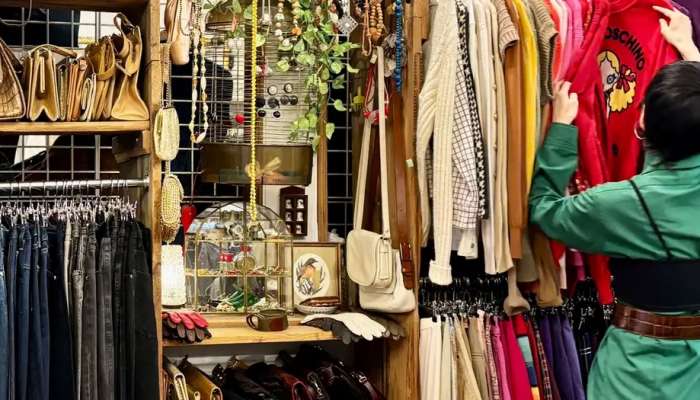
Vienna: Browsing for special clothes is one of Leonie's favorite hobbies. However, the 27-year-old fashion design student doesn't focus on the new collections from fashion companies. She instead looks specifically for second-hand pieces. And she finds most online.
"It's like a digital treasure hunt," says Leonie, describing her approach. It's important to enter the right keywords — and in different languages. That's when she's most likely to come across an unusual find. It's a great feeling.
Second-hand clothing goes mainstream
Leonie is not alone in her fascination with vintage. While vintage shopping used to mean rummaging through sometimes musty, cluttered stores, the online trade in second-hand products has been booming for years.
But among 15 to 30-year-olds, or so-called Generation Z, vintage has become a mainstream trend.
Second-hand has always been a part of youth fashion, says Elke Gaugele, Professor of Fashion and Styles at the Academy of Fine Arts in Vienna. But pre-worn apparel is presented differently in the media these days.
The change in image is reflected in the semantic shift from "second-hand" to "pre-loved" or "vintage."
By definition, vintage means that an item of clothing is at least 20 years old. But this is not the case online. The hashtag "vintage" also includes much newer items, including second-hand . Yet the term vintage exudes a feeling of exclusivity, and often also a price premium.
What makes vintage so attractive?
"Buying vintage is incredibly closely linked to self-perception," says fashion journalist and social media consultant Valentina Herbort.
She runs a Gen Z-focused Instagram channel with more than 70,000 followers titled: "The most important things in fashion & (pop) culture explained with substance & love."
Herbort sees the vintage trend primarily as a response to the desire for individuality. "Thanks to globalization, Gen Z has much broader fashion choices than previous generations. This gives rise to the desire to find their own individual style."
However, this is not so easy in a digital age where trends emerge in real time. "We all watch the same series and have the same inspiration," she says of mass media consumption. "That's why we all buy the same 23 items at Zara, even if there are 100 in the selection.
Getting value for money
In addition to the desire for uniqueness, Herbort also notes Gen Z's renewed focus on product quality. New jeans, for example, are of inferior quality to older models, and wearers "can tell the difference straight away," she says of the allure of used apparel.
"That's a strong selling point: buying something better for less.”
Sustainability and fair fashion production also play an important role for younger generations when buying clothes.
The fast fashion industry has long been criticized for poor working conditions, underpayment and environmental pollution. The vintage trend is "a conscious response from Gen Z" to this exploitation of people and the planet, said Elke Gaugele.
While giving clothing a second life is a more sustainable use of resources, trend researcher Eike Wenzel doubts that the vintage trend will actually result in fewer fast fashion purchases.
"Vintage is not a way out of the consumer society," she said.
This is confirmed by some vintage influencers on social media who unpack piles of online orders in so-called "thrift hauls."
What's more, vintage is no longer a timeless concept but, like fashion in general, is subject to trend cycles. In other words, what's trendy is not simply what's old. For example, "Y2K" is one current trend, which celebrates the 2000s — with low-rise pants, lots of glitter and a deliberately cheap look. So is fast fashion being replaced by "fast vintage," so to speak? Eike Wenzel agrees.
More than just a trend?
But for Valentina Herbort, the enthusiasm for vintage is mostly a positive development in terms of sustainability.
"People are realizing the benefits of quality second-hand clothing and are opting for vintage instead of fast fashion in the long term," she said.
Colombian Sandra Calderon sells special one-off pieces via her Instagram profile, "Revancha Vintage." She says the image of vintage is also changing in her home country, and is part of a movement away from second-hand clothes towards unique pieces that tell a story.
But vintage markets in Europe can contradict the principle of pre-loved apparel, she says.
"There is a huge supply of very high quality vintage, but the prices are sometimes inflationary, because it's trendy," she explained. "Sometimes a vintage piece costs more than something new. This contradicts the idea that vintage should be an affordable option."
Calderon's vision for the future matches with Leonie's closet — which is 90% filled with vintage pieces.
"Vintage and second-hand fashion should not just be a trend, but the first choice," she said.